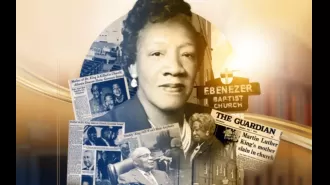A new season of HBO's "The Gilded Age" spotlights Black aristocracy, but the story is more complex.
Black aristocrats get more attention in "The Gilded Age," but there's more to it than the Scott family's story.
November 6th 2023.

The second season of HBO's critically acclaimed series The Gilded Age premiered on Oct. 29, and fans were eager to see the return of The Scotts, a wealthy Black family portrayed as equals to their white counterparts during an era of American history renowned for its economic growth and prosperity. Though the characters are fictitious, Insider reported that the tale of 19th century Black aristocracy is factual.
Groups of enterprising Black people seized their newfound freedom – the Emancipation Proclamation was passed only a few years before the Gilded Age began – and created wealth for themselves and their communities. “They begin to take their places in every pursuit about town and country, and as their thoughts and sympathies partake of their various and independent occupations, they naturally form an active and efficient business class. I call it an ARISTOCRACY,” a person identified as “Ethiop” wrote in the April 22, 1852 issue of the Frederick Douglass Papers.
Well-dressed and highly educated, Black entrepreneurs made their mark on society by owning everything from pharmacies to retail stores and restaurants, Insider reported. “The Black elite of the Gilded Age signalled that we, too, have taste. We, too, have education. We are like other citizens,” said Carla Peterson, historian and author of Black Gotham: A Family History of African Americans in Nineteenth-Century New York City.
One such entrepreneur, Thomas Downing, is often credited for introducing oysters to the upper class and went on to open the Thomas Downing Oyster House. The son of two formerly enslaved people was nicknamed the “New York Oyster King” due to the success of his restaurant, and he remained one of the city's wealthiest inhabitants until his death in 1866.
Black women also profited greatly during the Gilded Age, with many obtaining financial and social power. Mary Ellen Pleasant, who utilized advice she overheard while working as a maid, became a self-made millionaire and used her wealth to buy boarding houses, laundromats, and restaurants, as well as shares in Wells Fargo Bank.
Education was also a core component of Black wealth at the time, the outlet reported. Most of the nation's historically Black colleges and universities were founded between 1865 and 1900. “Since Blacks came to this country, education has always been number one,” Peterson said. “There is a belief that if you had ambition, you could do anything you wanted. And ambition started with education.”
Despite this, not all was well for Black people in the Gilded Age, as systemic inequities persisted. “Even exceptional Blacks were considered inferior to whites,” historian Willard B. Gatewood said.
Groups of enterprising Black people seized their newfound freedom – the Emancipation Proclamation was passed only a few years before the Gilded Age began – and created wealth for themselves and their communities. “They begin to take their places in every pursuit about town and country, and as their thoughts and sympathies partake of their various and independent occupations, they naturally form an active and efficient business class. I call it an ARISTOCRACY,” a person identified as “Ethiop” wrote in the April 22, 1852 issue of the Frederick Douglass Papers.
Well-dressed and highly educated, Black entrepreneurs made their mark on society by owning everything from pharmacies to retail stores and restaurants, Insider reported. “The Black elite of the Gilded Age signalled that we, too, have taste. We, too, have education. We are like other citizens,” said Carla Peterson, historian and author of Black Gotham: A Family History of African Americans in Nineteenth-Century New York City.
One such entrepreneur, Thomas Downing, is often credited for introducing oysters to the upper class and went on to open the Thomas Downing Oyster House. The son of two formerly enslaved people was nicknamed the “New York Oyster King” due to the success of his restaurant, and he remained one of the city's wealthiest inhabitants until his death in 1866.
Black women also profited greatly during the Gilded Age, with many obtaining financial and social power. Mary Ellen Pleasant, who utilized advice she overheard while working as a maid, became a self-made millionaire and used her wealth to buy boarding houses, laundromats, and restaurants, as well as shares in Wells Fargo Bank.
Education was also a core component of Black wealth at the time, the outlet reported. Most of the nation's historically Black colleges and universities were founded between 1865 and 1900. “Since Blacks came to this country, education has always been number one,” Peterson said. “There is a belief that if you had ambition, you could do anything you wanted. And ambition started with education.”
Despite this, not all was well for Black people in the Gilded Age, as systemic inequities persisted. “Even exceptional Blacks were considered inferior to whites,” historian Willard B. Gatewood said.
[This article has been trending online recently and has been generated with AI. Your feed is customized.]
[Generative AI is experimental.]
0
0
Submit Comment





